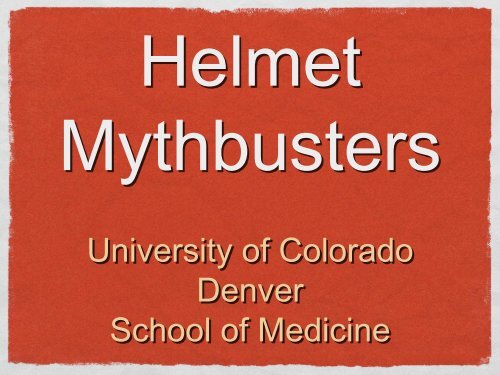Helmet Mythbusters
Helmet Mythbusters
Helmet Mythbusters
You also want an ePaper? Increase the reach of your titles
YUMPU automatically turns print PDFs into web optimized ePapers that Google loves.
<strong>Helmet</strong><br />
<strong>Mythbusters</strong><br />
University of Colorado<br />
Denver<br />
School of Medicine
Why are we here?
About the <strong>Helmet</strong> Heads<br />
Outreach project of the University of Colorado<br />
Emergency Medicine Interest Group<br />
Researching effects of education on injury<br />
prevention and helmet use<br />
Need your anonymous survey data to help develop<br />
educational programs for elementary school kids<br />
Working to provide bike helmets for low-income<br />
families
About the <strong>Helmet</strong> Heads<br />
• Plan for today:<br />
• Use science to evaluate the common<br />
reasons people don’t wear helmets
Top 5 Myths<br />
<strong>Helmet</strong>s...<br />
5. Only work at low speeds<br />
4. Don’t prevent traumatic<br />
brain injuries<br />
3. Encourage recklessness<br />
2. Increase cervical injuries<br />
1. Are only for beginners<br />
See items 6-10
Top 5 Myths<br />
<strong>Helmet</strong>s...<br />
5. Only work at low speeds<br />
4. Don’t prevent traumatic<br />
brain injuries<br />
3. Encourage recklessness<br />
2. Increase cervical injuries<br />
1. Are only for beginners<br />
See items 6-10
The Other 5<br />
<strong>Helmet</strong>s...<br />
• 10. Aren’t cool<br />
• 9. Are expensive fashion<br />
statements<br />
• 8. Block sensory perception<br />
• 7. Don’t protect against<br />
other injuries<br />
• 6. Are uncomfortable<br />
See items 1-5
Myth # 10<br />
<strong>Helmet</strong>s Aren’t Cool
The Myth<br />
The Details<br />
Wearing a helmet makes me look like a novice.<br />
The Reality<br />
As a patroller / instructor / employee, you are a<br />
role model.<br />
Your example can lead to increased helmet use<br />
and fewer injuries in kids and other guests.
• Click to return to list
Myth # 9<br />
<strong>Helmet</strong>s Are Expensive Fashion Statements
The Myth<br />
The Details<br />
The cost of helmets cannot be justified.<br />
The Reality<br />
<strong>Helmet</strong> use reduces healthcare costs, hospital<br />
length of stay, and deaths.
The Science<br />
23% higher healthcare costs for un-helmeted (vs.<br />
helmeted) motorcycle accident victims<br />
(Annals of Emergency Medicine)<br />
Seven seasons of skier/snowboarder fatalities:<br />
Predominant cause of death: head trauma<br />
<strong>Helmet</strong> use by those fatally injured: 0%<br />
(Journal of Trauma)
Air medical transport<br />
$1500 per hour<br />
Average ICU stay: 4.3 days<br />
$3500 per day<br />
CT Scan: $1700<br />
MRI: $3500<br />
Emergency Craniotomy<br />
$525,000
• Click to return to list
Myth # 8<br />
<strong>Helmet</strong>s Block Sensory Perception
The Myth<br />
The Details<br />
<strong>Helmet</strong>s cause an increase in accident rates by<br />
reducing hearing and/or peripheral vision.<br />
The Reality<br />
<strong>Helmet</strong> use does not significantly reduce<br />
peripheral vision nor diminish hearing.<br />
(Annals of Accident Prevention)
Example of Vision Standards
• Click to return to list
Myth # 7<br />
<strong>Helmet</strong>s Don’t Protect Against Other Injuries
The Myth<br />
The Details<br />
The extremities are most commonly injured in<br />
skiing and snowboarding. Head injuries make up<br />
relatively few of the proportion of injuries.<br />
The Reality<br />
Head injuries are the most expensive and most<br />
devastating injuries seen in skiing and<br />
snowboarding.<br />
Limiting the severity of a concomitant head injury<br />
reduces mortality in multi-system trauma.
The Science<br />
Of 361 Seriously injured skiers:<br />
Head injury mortality: 12%<br />
Multi-system trauma mortality: 6%<br />
Isolated thoracic or abdominal trauma mortality:<br />
0%<br />
Isolated extremity trauma mortality: 0%<br />
(Journal of Trauma)
• Click to return to list
Myth # 6<br />
<strong>Helmet</strong>s Are Uncomfortable
The Myth<br />
The Details<br />
Skiers and snowboarders often don’t wear<br />
helmets because they are uncomfortable.<br />
The Reality<br />
New helmets are lighter, fit better, and are more<br />
comfortable.
• Click to return to list
Myth # 5<br />
<strong>Helmet</strong>s Only Work At Low Speeds
The Myth<br />
The Details<br />
There is no evidence that helmets protect against<br />
high-energy impacts.<br />
The Reality<br />
A helmet provides better protection than no<br />
helmet at any speed.
The Science<br />
The science behind ski helmet<br />
impact testing is commonly<br />
misunderstood.<br />
<strong>Helmet</strong> dropped against anvil to<br />
impart specific amount of force<br />
(not a specific speed).<br />
Ski and snowboard helmets are<br />
tested to about the same impact<br />
as motorcycle helmets.
• Click to return to list
Myth # 4<br />
<strong>Helmet</strong>s Don’t Prevent Traumatic Brain Injuries
The Myth<br />
The Details<br />
<strong>Helmet</strong>s may prevent minor concussions but don't<br />
necessarily reduce the severity of traumatic brain<br />
injuries.<br />
The Reality<br />
Any helmet which disperses impact energy<br />
reduces the potential for traumatic brain injuries.
The Science<br />
75% reduction in severe traumatic brain injuries via<br />
helmet use in cycling (Journal of Sports Medicine)<br />
33% reduction in hospitalizations and 56%<br />
reduction in fatalities from motorcycle accidents<br />
during period of helmet enforcement (Taiwan)
Related Myth<br />
• See #9: <strong>Helmet</strong>s Are Expensive Fashion Statements<br />
• or<br />
• Click to return to list
Myth # 3<br />
<strong>Helmet</strong>s Encourage Recklessness
The Myth<br />
The Details<br />
People feel safer wearing helmets, so they are<br />
willing to take greater risks.<br />
The Reality<br />
Risk-taking is encouraged by the nature of certain<br />
professional and extreme sports.<br />
Age and gender influence risk-taking behavior far<br />
more than helmet use.
The Science<br />
Young males are at significantly higher risk of head<br />
injury due to risk-taking behavior, not helmet use.<br />
(Journal of Trauma)<br />
Non-helmeted motorcycle riders exceed the speed<br />
limit more frequently than helmeted riders. (Annals<br />
of Emergency Medicine)
• Click to return to list
Myth # 2<br />
<strong>Helmet</strong>s Increase Cervical Injuries
The Myth<br />
The Details<br />
The weight of a helmet increases the chance<br />
that the wearer will suffer a neck injury.<br />
The Reality<br />
Cochrane Review found no well conducted<br />
studies relating cervical injury rates to helmet use.
The Science<br />
In a study of consecutive cases of skiers and<br />
snowboarders with spinal injuries<br />
(St. Anthony Central)<br />
Of patients with cervical injuries, none were<br />
wearing helmets<br />
Of patients wearing helmets, none suffered<br />
cervical injuries<br />
No cervical injuries in helmeted kids under 13
The Science<br />
Un-helmeted children are 2.24 times more likely<br />
than helmeted children to suffer head/neck/facial<br />
injuries. (Journal of Injury Prevention)<br />
No change in incidence of cervical injuries after<br />
implementation of mandatory helmet law in<br />
Taiwan.
• Click to return to list
Myth # 1<br />
<strong>Helmet</strong>s Are Only For Beginners
The Myth<br />
The Details<br />
Increased skill levels make helmets unnecessary<br />
because of a lower incidence of head injuries.<br />
The Reality<br />
Advanced-level skiers are more likely to suffer<br />
head injuries than beginners or intermediates.
The Science<br />
One study of injured skiers found that 26% were<br />
beginners, 29% intermediates, and 45%<br />
advanced.<br />
(Journal of Trauma)<br />
<strong>Helmet</strong> use is associated with expert ability,<br />
higher number of days skied per year, and higher<br />
education, all factors correlating with lower<br />
incidence of head injuries.<br />
(Journal of Trauma)
What Happened in Jackson<br />
Kathryn Miller Hess<br />
died in March 2009<br />
Patroller at Jackson<br />
Hole<br />
Slipped and fell<br />
through a rocky<br />
section during<br />
backcountry patrol
• Click to return to list



